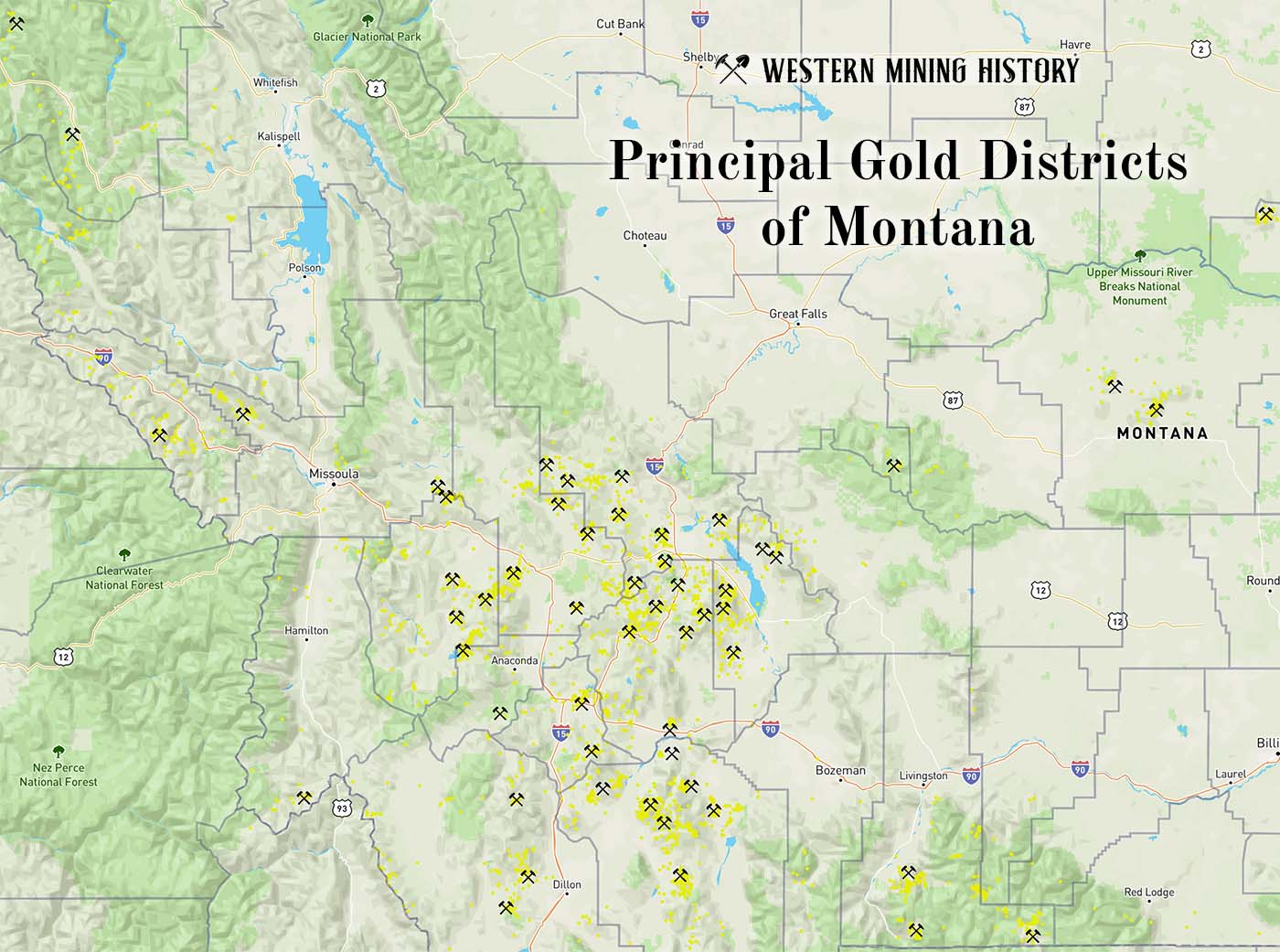The Antimony Mines is a antimony mine located in Sanders county, Montana at an elevation of 3,999 feet.
About the MRDS Data:
All mine locations were obtained from the USGS Mineral Resources Data System. The locations and other information in this database have not been verified for accuracy. It should be assumed that all mines are on private property.
Mine Info
Elevation: 3,999 Feet (1,219 Meters)
Commodity: Antimony
Lat, Long: 47.57222, -115.58944
Map: View on Google Maps
Antimony Mines MRDS details
Site Name
Primary: Antimony Mines
Secondary: Stibnite Hill
Secondary: Barto
Secondary: Babbit
Secondary: Coeur D'Alene
Secondary: Eureka and Ellis
Secondary: Interstate
Commodity
Primary: Antimony
Tertiary: Copper
Tertiary: Arsenic
Tertiary: Zinc
Tertiary: Silver
Tertiary: Gold
Location
State: Montana
County: Sanders
District: Prospect Creek District
Land Status
Land ownership: Private
Note: the land ownership field only identifies whether the area the mine is in is generally on public lands like Forest Service or BLM land, or if it is in an area that is generally private property. It does not definitively identify property status, nor does it indicate claim status or whether an area is open to prospecting. Always respect private property.
Holdings
Not available
Workings
Type: Underground
Ownership
Owner Name: U.S. Antimony Corp.
Owner Name: J. C. Lawrence
Production
Year: 1953
Time Period: 1940 - 1953
Material type: ORE
Description: Cp_Grade: ^25.8% Sb
Deposit
Record Type: Site
Operation Category: Producer
Operation Type: Unknown
Discovery Year: 1884
Discovery Method: Ore-Mineral In Place
Years of Production:
Organization:
Significant: N
Deposit Size: M
Physiography
General Physiographic Area: Rocky Mountain System
Physiographic Province: Northern Rocky Mountains
Physiographic Detail: Bitterroot Mountains
Mineral Deposit Model
Not available
Orebody
Form: TABULAR/BLANKET
Form: TABULAR/BLANKET
Structure
Type: R
Description: N - S Trending Anticline
Type: L
Description: North Plunging Gently Rolling Folds. Large Ne Trending Fault Near The Portal Of The Barto Adit. Steeply Dipping Fault ( 81 Deg Sw ) 1500 Ft Ne Of The Babbit Adit.
Alterations
Not available
Rocks
Name: Quartzite
Role: Host
Age Type: Host Rock
Age Young: Neoproterozoic
Name: Quartzite
Role: Host
Age Type: Host Rock Unit
Age Young: Neoproterozoic
Analytical Data
Not available
Materials
Ore: Sphalerite
Ore: Chalcopyrite
Ore: Stibnite
Gangue: Quartz
Gangue: Pyrite
Comments
Comment (Geology): QUARTZ AND STIBNITE ARE THE MOST ABUNDANT VEIN MINERALS.
Comment (Workings): IN THE PAST, NUMEROUS ADITS AND PROSPECT PITS HAVE BEEN OPENED ALONG THE ANTIMONY VEINS. IN 1960 ONLY 2 ADITS, THE BARTO AND THE BABBIT WERE ACCESSIBLE: THE BARTO WAS ACCESSIBLE FOR 340 FT; THE BABBIT WAS OPEN FOR ITS ENTIRE LENGTH OF 260 FT. 1973 PUBLICATION STATES THAT A MODIFIED ROOM AND PILLAR METHOD IS USED IN MINE. WHILE VEINS GENERALLY DIP LESS THAN 30 DEG, MINING IS COMPLICATED BY HIGH ANGLE FAULTS.
Comment (Deposit): BATTERY GRADE SB PRODUCED IN FURNACE - 95 - 96% SB; SODIUM ANTIMONATE, ALSO PRODUCED BY FIRST LEACHING CONCENTRATE - USED IN GLASS INDUSTRY. FUTURE PLANS TO FUME SB TO SB203 REPORTED BY J. LAWRENCE, PRESIDENT, U.S. ANTIMONY. ; INFO.SRC : 1 PUB LIT
Comment (Production): PRODUCTION FROM COEUR D'ALENE, EUREKA & ELLIS, INTERSTATE, AND STIBNITE HILL MINES IN 1941. IN 1942, COUER D'ALENE DID NOT PRODUCE. THE OTHER THREE DID, AS WELL AS AN UNNAMEDMINE. STIBNITE HILL MINE PRODUCED IN 1951 AND 1953. MINOR PRODUCTION IN EARLY 1900'S. CURRENTLY PRODUCING.
Comment (Development): PROPERTY WAS IDLE FROM MID 1900'S TO WW II. DURING WW II OWNERSHIP WAS DIVIDED AMONG SEVERAL GROUPS. KNUTE KIRKEBERG CONSOLIDATED OWNERSHIP OF PROPERTIES BETWEEN 1964 AND 1968 . IN 1969 PROPERTY WAS SOLD TO US ANTIMONY CORP. ; ECON.COM: 350 TON/DAY MILL WITH REFINERY
Comment (Deposit): MOST VEINS STRIKE NE AND DIP AT LOW ANGLES TO THE NW. VEINS RANGE IN WIDTH FROM 5 FT TO LESS THAN 1 IN AND METALLIC CONTENT ALSO DIFFERS CONSIDERABLY ALONG THE VEIN. IN PART, THE VEINS APPEAR TO BE BEDDING PLANE VEINS, BUT SOME ARE CROSSCUTTING. STIBNITE MOST OFTEN OCCURS AS NARROW 1 - 6 IN VEINS OR ELONGATED LENSES THROUGHOUT THE OVERALL VEIN STRUCTURE.
References
Reference (Deposit): CLENDENIN, C. W., JR., 1973, STIBNITE - BEARING VEINS AT STIBNITE HILL, SANDERS CO. MT., MT. COL. MIN. SCI. & TECH. (MASTERS THESIS.)
Reference (Deposit): CROWLEY, F. A., 1963 , MINES AND MINERAL DEPOSITS (EXCEPT FUELS) SANDERS COUNTY, MONTANA: MONTANA BUREAU OF MINES AND GEOLOGY BULL. 34 , PP. 27 - 30 .
Reference (Production): CROWLEY, F. A., 1963 : MONTANA BUREAU OF MINES AND GEOLOGY BULL. 34 , P. 28 .
Principal Gold Districts of Montana

In Montana, 54 mining districts have each have produced more than 10,000 ounces of gold. The largest producers are Butte, Helena, Marysville, and Virginia City, each having produced more than one million ounces. Twenty seven other districts are each credited with between 100,000 and one million ounces of gold production. Read more: Principal Gold Districts of Montana.